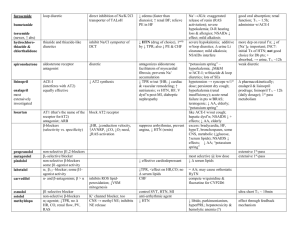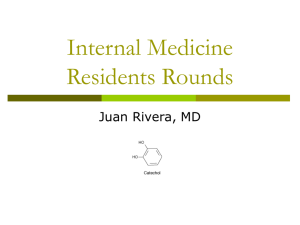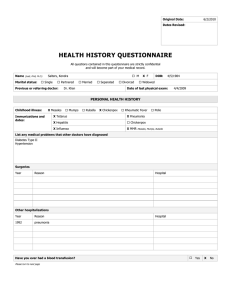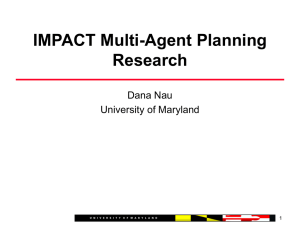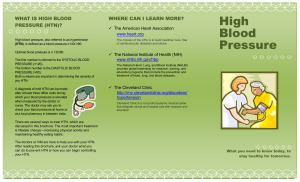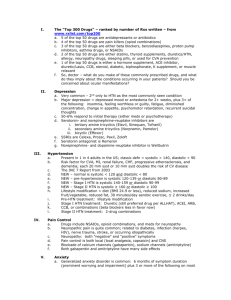Secondary Hypertension Jimmy Klemis, MD June 20, 2002
advertisement
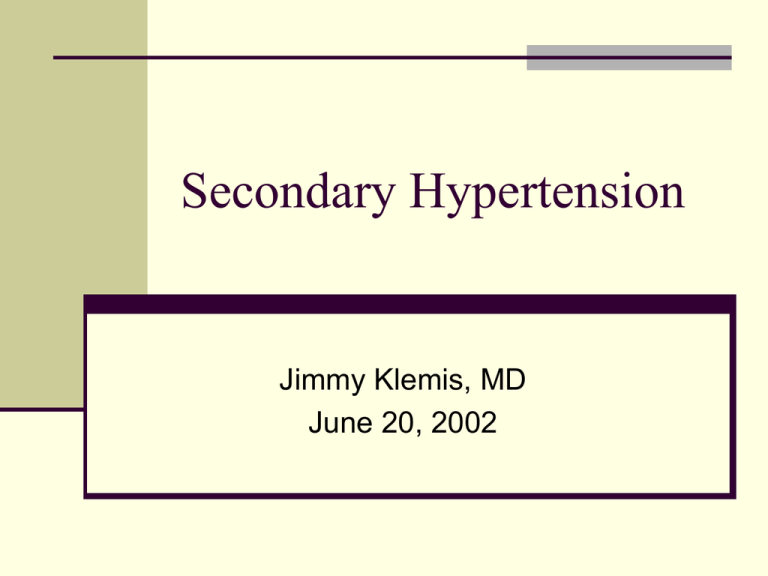
Secondary Hypertension Jimmy Klemis, MD June 20, 2002 Overview HTN affects 43 million adults in US 95% have “essential HTN” without identifiable and treatable cause “ Secondary” HTN accounts for ~5-10% of other cases and represents potentially curable disease Often overlooked and underscreened Controversy over screening and treatment in some cases Screening Testing can be expensive and requires clinical suspicion and knowledge of limitations of different tests General principles: New onset HTN if <30 or >50 years of age HTN refractory to medical Rx (>3-4 meds) Specific clinical/lab features typical for dz i.e., hypokalemia, epigastric bruits, differential BP in arms, episodic HTN/flushing/palp, etc Systemic HTN - Pathophysiology Desmukh, et al. Pathophysiology of Heart Disease, Ch 13. 1997 Causes of Secondary HTN Common Intrinsic Renal Disease Renovascular Dz Mineralocorticoid excess/ aldosteronism ? Sleep Breathing d/o Uncommon Pheochromocytoma Glucocorticoid excess/ Cushing’s dz Coarctation of Aorta Hyper/hypothyroidism Renal Parenchymal Disease Common cause of secondary HTN (2-5%) HTN is both cause and consequence of renal disease Multifactorial cause for HTN including disturbances in Na/water balance, depletion or antagonism of vasodepressors/ prostaglandins, pressor effects on TPR Renal disease from multiple etiol, treat underlying disease, dialysis/ transplant if necessary Renovascular HTN Incidence 1-30% Etiology Atherosclerosis 75-90% Fibromuscular dysplasia 10-25% Other Aortic/renal dissection Takayasu’s arteritis Thrombotic/cholesterol emboli CVD Post transplantation stenosis Post radiation Renovascular HTN Safian & Textor. NEJM 344:6;p 432 Renovascular HTN - Pathophysiology Decrease in renal perfusion pressure activates RAAS, renin release converts angiotensinogen Ang I; ACE converts Ang I Ang II Ang II causes vasoconstriction (among other effects) which causes HTN and enhances adrenal release of aldosterone; leads to sodium and fluid retention Contralateral kidney (if unilateral RAS) responds with diuresis/ Na, H2O excretion which can return plasma volume to normal with sustained HTN, plasma renin activity decreases (limited usefulness for dx Bilateral RAS or solitary kidney RAS leads to rapid volume expansion and ultimate decline in renin secretion Renovascular HTN - Clinical History onset HTN age <30 or >55 Sudden onset uncontrolled HTN in previously well controlled pt Accelerated/malignant HTN Intermittent pulm edema with nl LV fxn PE/Lab Epigastric bruit, particulary systolic/diastolic Azotemia induced by ACEI Unilateral small kidney Renovascular HTN - diagnosis Physical findings (bruit) Duplex U/S Captopril renography Magnetic Resonance Angiography Renal Angiography RAS screening/diagnostics Sens Spec Cost Duplex U/S 9095% 6090% $117 Limitation/Etc Operator dependent, 10-20% 8793% $968 Meds, accuracy reduced in pt with renal insufficiency, lacks anatomical info; good predictor of BP response MRA 8895% 95% $572 ? False positive artifact resp, peristalsis, tortuous vessels; cost Bruit 3965% 9099% - Insensitive, severe stenosis may be silent Angiography Gold std Gold std ? Invasive, nephrotoxicity, little value in predicting BP response Captopril Renography 8391% Fibromuscular dysplasia 10-25% of all RAS Young female, age 15-40 Medial disease 90%, often involves distal RA ~ 30% progressively worsen but total occlusion is rare Treatment – PTRA Successful in 82-100% of patients Restenosis in 5-11% “Cure” of HTN in ~60% Atherosclerotic RAS 75-90% of RAS Usually men, age>55, other atherosclerotic dz Progression of stenosis 51% @ 5years, 3-16% to occlusion, with renal atrophy noted in 21% of RAS lesions >60% ESRD in 11% ( higher risk if >60%, baseline renal insufficiency, SBP>160) Treatment PTRA success 60-80% with restenosis 10-47% Stent success 94-100% with restenosis 11-23% (1yr) “Cure” of RV HTN <30% Fibromuscular Dysplasia, before and after PTRA Safian & Textor. NEJM 344:6; Atherosclerotic RAS before and after stent Renovascular HTN – Medical Rx Aggressive risk fx modification (lipid, tobacco, etc) ACEI/ARB safe in unilateral RAS if careful titration and close monitoring; contraindicated in bilat RAS or solitary kidney RAS Renovascular HTN - principles Not all RAS causes HTN or ischemic nephropathy Differing etiology of RAS has different outcomes in regards to treatment (FMD vs atherosclerosis) No current rationale for “drive-by” interventions Importance of medical rx No current consensus guidelines for screening/outcomes/treatment ( as opposed to carotid artery stenosis, AAA, etc) Primary Aldosteronism Prevalence .5- 2.0% (5-12% in referral centers) Etiology Adrenal adenoma Other: bilat adrenal hyperplasia, glucocorticoid suppressible hyperaldo, adrenal carcinoma Clinical: May be asymptomatic; headache, muscle cramps, polyuria Retinopathy, edema uncommon Hypokalemia (K normal in 40%), metabolic alkalosis, high-nl Na Primary Aldosteronism- Dx Aldosterone / Plasma Renin Activity ratio Early am after ambulation ~10-15 min Ratio >20-25 with PRA <1 and Aldo >15 should prompt further testing, endo referral Confirmatory/physiologic testing Withold BP meds 2wks High serum aldo after IV saline (1.25L x 2hr) load followed by low PRA after salt restricted diet (40mg/d) or diuretic (lasix up to 120mg) serum aldo <8.5 ng/dL after IV saline rules out primary aldosteronism Imaging – CT, scintography Primary Aldosteronism - Treatment Surgical removal of adrenal tumor, can be done laparoscopically Pretreatment for 3-4 wks with spironolactone minimizes postoperative hypoaldosteronism and restores K to normal levels, response of BP to spiro treatment is predictor of surgical outcome Aldosteronoma Obstructive Sleep Apnea Published reports estimate incidence of 30-80% of pt with essential HTN have OSA and 50% pt with OSA have HTN1 Prospective studies show link between OSA (apneichyponeic index) and development of HTN independent of other risk fx2 Clinical Daytime somnolescence, am headaches, snoring or witnessed apneic episodes Dx – Sleep studies Rx – wt loss, CPAP, surgical (UPPP) 1Silverberg, 2 et al.Curr Opinion Nephrol Hyperten 1998:7;353-361 OSA – BP improvement with Rx Pankow, et al. NEJM 343:966-967 Causes of Secondary HTN Common Intrinsic Renal Disease Renovascular Dz Mineralocorticoid excess/ aldosteronism ? Sleep Breathing d/o Uncommon Pheochromocytoma Glucocorticoid excess/ Cushing’s dz Coarctation of Aorta Hyper/hypothyroidism Pheochromocytoma Rare cause of HTN (.1-1.0%) Tumor containing chromaffin cells which secrete catecholamines Young-middle age with female predominance Clinical Intermittent HTN, palpitations, sweating, anxiety “spells” May be provoked by triggers such as tyramine-containing foods (beer,cheese,wine), pain, trauma, drugs (clonidine, TCA, opiates) Pheochromocytoma - Screen Best detected during or immediately after episodes Plasma free metanephrine >.66nmol/L 24hr urine metanephrine (>3.7nmol/d) 24 urine VMA Sensitivity 99% Specificity 89% 77% (95%) 93% (96%) 64% 95% Lenders, et al. JAMA 2002 Mar 20;287(11):1427-34 Pheochromocytoma - Diagnosis Imaging for localization of tumor Sens Spec PPV NPV (MIBG) scintigraphy 78% 100% 100% 87% CT 98% 70% 69% 98% MRI 100% 67% 83% 100% Akpunonu, et al. Dis Month.October 1996, p688 Pheochromocytoma - treatment Surgical removal of tumor Anesthesia- avoid benzo, barbiturates or demerol which can trigger catechol release Complications include ligation of renal artery, post op hypoglycemia, hemorrhage and volume loss Mort 2%, 5 yr survival 95% with <10% recurrence Caution with BB – can cause unopposed alpha stimulation/pheo crisis BP control with alpha blockers (phentolamine, phenoxybenzamine, and prazosin) Cushing’s syndrome/ hypercortisolism Rare cause of secondary HTN (.1-.6%) Etiology: pituitary microadenoma, iatrogenic (steroid use), ectopic ACTH, adrenal adenoma Clinical Sudden weight gain,truncal obesity, moon facies, abdominal striae, DM/glucose intolerance, HTN,prox muscle weakness, skin atrophy, hirsutism/acne Cushings syndrome Cushings syndrome - dx Screen: 24 Hr Urine free cortisol >90ug/day is 100% sens and 98% spec false + in Polycystic Ovarian Syndrome, depression Confirm Low dose dexamethasone suppression test 1mg dexameth. midnight, measure am plasma cortisol (>100nmol is +) Other tests include dexa/CRH suppresion test Imaging CT/MRI head (pit) chest (ectopic ACTH tumor) Cushings syndrome - Rx Cushings dz/ pit adenoma Transphenoidal resection Pituitary irradiation Bromocriptine, octreotide Adrenal tumors - adrenalectomy Removal of ACTH tumor Coarctation of Aorta Congenital defect, male>female Clinical Differential systolic BP arms vs legs (=DBP) May have differential BP in arms if defect is prox to L subclavian art Diminished/absent femoral art pulse Often asymptomatic Assoc with Turners, bicuspid AV If uncorrected 67% will develop LV failure by age 40 and 75% will die by age 50 Surgical Rx, long term survival better if corrected early Coarctation of Aorta Brickner, et al. NEJM 2000;342:256-263 Hyperthyroidism 33% of thyrotoxic pt develop HTN Usually obvious signs of thyrotoxicosis Dx: TSH, Free T4/3, thyroid RAIU Rx: radioactive ablation, propanolol Hypothyroidism 25% hypothyroid pt develop HTN Mechanism mediated by local control, as basal metabolism falls so does accumulation of local metabolites; relative vasoconstriction ensues Conclusions Remember clinical/diagnostic features of common forms of secondary HTN Important to appropriately screen pt suspected of having potentially correctable causes of HTN Understand limitations of screening/treatment (atherosclerotic RAS)

